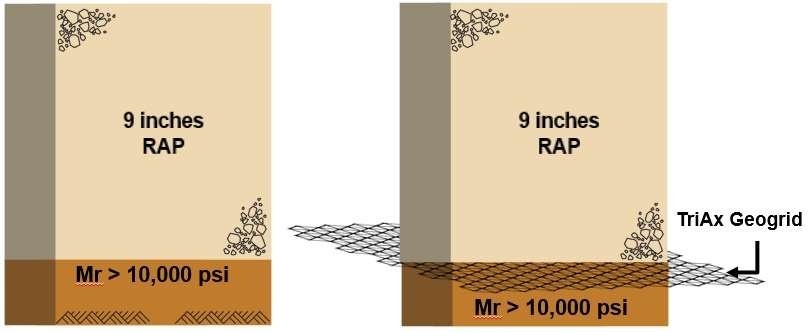The Road to Sustainability
by Wendy McBay, on August 10, 2018
How the use of geogrid materials prolongs the lifetime of recycled materials and reduces the carbon footprint of highway construction

For thousands of years, engineers have endeavored to devise better products and systems to support growth and human progress. Always thinking towards the future, engineers prioritized sustainability long before it ever became the standard for conscionable building and innovation. Today, engineers embed sustainability into every aspect of roadway construction – and they are achieving measurable results through the use of geogrid materials.
Population growth demands improved infrastructure. Existing roadways are supporting unprecedented traffic volumes, and engineering teams are continually tasked with delivering roadway reconstruction projects more quickly, efficiently and with minimal disruption to current traffic flows. Recycled asphalt has been an increasing part of the solution. A 2017 National Asphalt Pavement Association survey found that more than 76.2 million tons of reclaimed asphalt pavement (RAP) and nearly 950,000 tons of reclaimed asphalt shingles (RAS) were used in new asphalt pavement mixes in the United States during 2017.
In the past, engineers and contractors have expedited roadway reconstruction projects by recycling existing road base. However, this method poses risks related to potential non-uniformities of recycled material – risks that can decrease pavement life, prolong construction efforts and create higher project costs. Eager to improve roadway performance while utilizing the environmentally friendly method of reusing aggregate base materials for improved roadway projects, Tensar International created TriAx Geogrid. When used in conjunction with recycled asphalt pavement (RAP) and other recycled materials, TriAx Geogrid provides enhanced performance beyond that of roadways only utilizing recycled aggregate base.
Manufactured from a punched polypropylene sheet oriented in multiple equilateral directions to leverage the strength of triangular geometry, TriAx Geogrid provides an enhanced level of in-plane stiffness for recycled materials. This high rib structure interlocks and confines with the aggregate base to yield a stiffer and more uniform foundation that maintains integrity over time. The confinement results in increased load capacity of the aggregate base and also reduces the potential for contamination of the aggregate base with the subgrade soil. Ultimately, the shape delivers optimal in-service stress transfer from the aggregate to the stabilizing geogrid.
Field testing substantiates sustainability of the geogrid
 An independent firm recently performed a series of Automated Plate Load Tests (APLT) of roadway sections in Tulare, CA to simulate traffic loading over time per AASHTO and ASTM test methods. The APLT tested in-place aggregate base with and without the use of TriAx geogrid. At over 10,000 cycles, the control section of recycled aggregate base experienced permanent deformation four times that of the composite section stabilized by the TriAx geogrid.
An independent firm recently performed a series of Automated Plate Load Tests (APLT) of roadway sections in Tulare, CA to simulate traffic loading over time per AASHTO and ASTM test methods. The APLT tested in-place aggregate base with and without the use of TriAx geogrid. At over 10,000 cycles, the control section of recycled aggregate base experienced permanent deformation four times that of the composite section stabilized by the TriAx geogrid.

 Figure 1: 9 inches RAP, No Geogrid
Figure 1: 9 inches RAP, No Geogrid
 Figure 2: 9 inches RAP, Geogrid
Figure 2: 9 inches RAP, Geogrid
These polymeric products support the continued use of recycled aggregate base, which reduces the amount of new material needed for the construction of new or reconstructed roadways. This reuse minimizes truck trips needed to and from construction sites, thus reducing CO2 emissions from construction traffic. Geogrids also prolong the lifetime of roadways, which reduces long-term maintenance costs and saves owners time and money while additionally limiting greenhouse gas contribution.
In roadway construction, geogrid materials offer multiple sustainable benefits to prolong infrastructure longevity and reduce maintenance requirements. Increased infrastructure lifespans eliminate related construction traffic, which results in reduced carbon emissions. As projects utilizing geogrid require less overall stabilizing materials and emit less CO2 emissions, owners benefit from improved project schedules, reduced impacts to the environment and lower materials costs to save both time and money. Ultimately, the use of geogrid materials allow engineers to embed sustainability while meeting the needs of growing populations.
Did you know our staff is also able to help evaluate conditions and provide design assistance - at no cost to you? We have assisted contractors and engineers on thousands of projects and have the expertise, research and engineering to help provide cost and time savings to your projects.



